A Thorough Review of Cooling Concepts and Thermal Management Techniques for Automotive WBG Inverters: Topology, Technology and Integration Level
Abstract
:1. Introduction
2. Wide-Bandgap Semiconductors
3. Classification of Existing Cooling Techniques
4. Air Cooling
5. Liquid Cooling
5.1. Single-Sided Cooling
5.2. Double-Sided Cooling
6. Other Promising Cooling Approaches
7. Comparison of Cooling Techniques
- The higher operating temperature of WBG devices leads to the design and use of simpler and cheaper cooling techniques;
- The higher switching frequencies and lower losses increase the overall efficiency of the device;
- The smaller size and higher heat flux of the WBG die is suitable for compact devices, although this is challenging for cooling system design because more heat should be dissipated from a smaller area.
8. Conclusions
Author Contributions
Funding
Acknowledgments
Conflicts of Interest
References
- Giampieri, A.; Ling-Chin, J.; Ma, Z.; Smallbone, A.; Roskilly, A.P. A Review of the Current Automotive Manufacturing Practice from an Energy Perspective. Appl. Energy 2020, 261, 114074. [Google Scholar] [CrossRef]
- Dieselnet, 2020, Emission Standarts: Europe: Cars: Greenhouse Gas Emissions. Available online: https://dieselnet.com (accessed on 26 November 2020).
- An Official Website of the European Union. European Commission. Climate Strategies & Targets. Available online: https://ec.europa.eu/clima/policies/strategies_en (accessed on 26 November 2020).
- ACEA. European Automobile Manufacturers Association. 2019. Available online: https://www.acea.be (accessed on 26 November 2020).
- Rajashekara, K. Present Status and Future Trends in Electric Vehicle Propulsion Technologies. IEEE J. Emerg. Sel. Top. Power Electron. 2013, 1, 3–10. [Google Scholar] [CrossRef]
- Reimers, J.; Dorn-Gomba, L.; Mak, C.; Emadi, A. Automotive Traction Inverters: Current Status and Future Trends. IEEE Trans. Veh. Technol. 2019, 68, 3337–3350. [Google Scholar] [CrossRef]
- Hazra, S.; De, A.; Cheng, L.; Palmour, J.; Schupbach, M.; Hull, B.A.; Allen, S.; Bhattacharya, S. High Switching Performance of 1700-V, 50-A SiC Power MOSFET over Si IGBT/BiMOSFET for Advanced Power Conversion Applications. IEEE Trans. Power Electron. 2016, 31, 4742–4754. [Google Scholar] [CrossRef]
- López, I.; Ibarra, E.; Matallana, A.; Andreu, J.; Kortabarria, I. Next Generation Electric Drives for HEV/EV Propulsion Systems: Technology, Trends and Challenges. Renew. Sustain. Energy Rev. 2019, 114, 109336. [Google Scholar] [CrossRef]
- Kang, S.S. Advanced Cooling for Power Electronics. In Proceedings of the 2012 7th International Conference on Integrated Power Electronics Systems (CIPS), Nuremberg, Germany, 6–8 March 2012; pp. 1–8. [Google Scholar]
- Behi, H.; Karimi, D.; Behi, M.; Jaguemont, J.; Ghanbarpour, M.; Behnia, M.; Berecibar, M.; van Mierlo, J. Thermal Management Analysis Using Heat Pipe in the High Current Discharging of Lithium-Ion Battery in Electric Vehicles. J. Energy Storage 2020, 32, 101893. [Google Scholar] [CrossRef]
- Li, W.; Peng, X.; Xiao, M.; Garg, A.; Gao, L. Multi-Objective Design Optimization for Mini-Channel Cooling Battery Thermal Management System in an Electric Vehicle. Int. J. Energy Res. 2019, 43, 3668–3680. [Google Scholar] [CrossRef]
- Gai, Y.; Kimiabeigi, M.; Chuan Chong, Y.; Widmer, J.D.; Deng, X.; Popescu, M.; Goss, J.; Staton, D.A.; Steven, A. Cooling of Automotive Traction Motors: Schemes, Examples, and Computation Methods. IEEE Trans. Ind. Electron. 2019, 66, 1681–1692. [Google Scholar] [CrossRef] [Green Version]
- Dai, H.; Jahns, T.M.; Torres, R.A.; Liu, M.; Sarlioglu, B.; Chang, S. Development of High-Frequency WBG Power Modules with Reverse-Voltage-Blocking Capability for an Integrated Motor Drive Using a Current-Source Inverter. In Proceedings of the 2018 IEEE Energy Conversion Congress and Exposition (ECCE), Portland, OR, USA, 23–27 September 2018; pp. 1808–1815. [Google Scholar] [CrossRef]
- de Lillo, L.; Ahmadi, B.; Empringham, L.; Johnson, M.; Espina, J.; Abebe, R. Next Generation Integrated Drive, NGID: A Novel Approach to Thermal and Electrical Integration of High Power Density Drives in Automotive Applications. In Proceedings of the 2018 IEEE Energy Conversion Congress and Exposition (ECCE), Portland, OR, USA, 23–27 September 2018; pp. 1228–1232. [Google Scholar] [CrossRef]
- Alipour, M.; Hassanpouryouzband, A.; Kizilel, R. Investigation of the Applicability of Helium-Based Cooling System for Li-Ion Batteries. Electrochem 2021, 2, 11. [Google Scholar] [CrossRef]
- Murakami, Y.; Tajima, Y.; Tanimoto, S. Air-Cooled Full-SiC High Power Density Inverter Unit. In Proceedings of the 2013 World Electric Vehicle Symposium and Exhibition (EVS27), Barcelona, Spain, 17–20 November 2013; pp. 1–4. [Google Scholar] [CrossRef] [Green Version]
- Jia, X.; He, F.; Liu, C.; Hu, C.; Li, Y.; BORONKA, A.; Xu, D. Design of High Efficiency Inverter with Air Cooling for Electric Vehicle. In Proceedings of the 2018 IEEE International Power Electronics and Application Conference and Exposition (PEAC), Shenzhen, China, 4–7 November 2018; pp. 1–6. [Google Scholar] [CrossRef]
- Zeng, Z.; Zhang, X.; Blaabjerg, F.; Chen, H.; Sun, T. Stepwise Design Methodology and Heterogeneous Integration Routine of Air-Cooled SiC Inverter for Electric Vehicle. IEEE Trans. Power Electron. 2020, 35, 3973–3988. [Google Scholar] [CrossRef]
- Wrzecionko, B.; Bortis, D.; Kolar, J.W. A 120 °C Ambient Temperature Forced Air-Cooled Normally-off SiC JFET Automotive Inverter System. IEEE Trans. Power Electron. 2014, 29, 2345–2358. [Google Scholar] [CrossRef]
- Wang, Y.; Jones, S.; Dai, A.; Liu, G. Reliability Enhancement by Integrated Liquid Cooling in Power IGBT Modules for Hybrid and Electric Vehicles. Microelectron. Reliab. 2014, 54, 1911–1915. [Google Scholar] [CrossRef]
- Hou, F.; Wang, W.; Cao, L.; Li, J.; Su, M.; Lin, T.; Zhang, G.; Ferreira, B. Review of Packaging Schemes for Power Module. IEEE J. Emerg. Sel. Top. Power Electron. 2020, 8, 223–238. [Google Scholar] [CrossRef] [Green Version]
- Razeeb, K.M.; Dalton, E.; Cross, G.L.W.; Robinson, A.J. Present and Future Thermal Interface Materials for Electronic Devices. Int. Mater. Rev. 2018, 63, 1–21. [Google Scholar] [CrossRef]
- Pan, C.A.; Yeh, C.T.; Qiu, W.C.; Lin, R.Z.; Hung, L.Y.; Ng, K.T.; Lin, C.F.; Chung, C.K.; Jiang, D.S.; Hsiao, C.S. Assembly and Reliability Challenges for Next Generation High Thermal TIM Materials. In Proceedings of the 2017 IEEE 67th Electronic Components and Technology Conference (ECTC), Orlando, FL, USA, 30 May–2 June 2017; pp. 2033–2039. [Google Scholar] [CrossRef]
- Hansson, J.; Nilsson, T.M.J.; Ye, L.; Liu, J. Novel Nanostructured Thermal Interface Materials: A Review. Int. Mater. Rev. 2018, 63, 22–45. [Google Scholar] [CrossRef]
- Zhang, Y.; Heo, Y.J.; Son, Y.R.; In, I.; An, K.H.; Kim, B.J.; Park, S.J. Recent Advanced Thermal Interfacial Materials: A Review of Conducting Mechanisms and Parameters of Carbon Materials. Carbon 2019, 142, 445–460. [Google Scholar] [CrossRef]
- Morya, A.K.; Gardner, M.C.; Anvari, B.; Liu, L.; Yepes, A.G.; Doval-Gandoy, J.; Toliyat, H.A. Wide Bandgap Devices in AC Electric Drives: Opportunities and Challenges. IEEE Trans. Transp. Electrif. 2019, 5, 3–20. [Google Scholar] [CrossRef]
- Su, M.; Chen, C.; Sharma, S.; Kikuchi, J. Performance and Cost Considerations for SiC-Based HEV Traction Inverter Systems. In Proceedings of the IEEE 3rd Workshop on Wide Bandgap Power Devices and Applications (WiPDA), Blacksburg, VA, USA, 2–4 November 2015; pp. 345–350. [Google Scholar] [CrossRef]
- Catalano, A.P.; Scognamillo, C.; Castellazzi, A.; d’Alessandro, V. Optimum Thermal Design of High-Voltage Double-Sided Cooled Multi-Chip SiC Power Modules. In Proceedings of the 2019 25th International Workshop on Thermal Investigations of ICs and Systems (THERMINIC), Lecco, Italy, 25–27 September 2019; pp. 1–4. [Google Scholar] [CrossRef]
- Karimi, D.; Behi, H.; Jaguemont, J.; el Baghdadi, M.; van Mierlo, J.; Hegazy, O. Thermal Concept Design of MOSFET Power Modules in Inverter Subsystems for Electric Vehicles. In Proceedings of the 2019 9th International Conference on Power and Energy Systems (ICPES), Perth, WA, Australia, 10–12 December 2019; pp. 1–6. [Google Scholar] [CrossRef]
- She, X.; Huang, A.Q.; Lucia, O.; Ozpineci, B. Review of Silicon Carbide Power Devices and Their Applications. IEEE Trans. Ind. Electron. 2017, 64, 8193–8205. [Google Scholar] [CrossRef]
- Husain, I.; Ozpineci, B.; Islam, M.S.; Gurpinar, E.; Su, G.J.; Yu, W.; Chowdhury, S.; Xue, L.; Rahman, D.; Sahu, R. Electric Drive Technology Trends, Challenges, and Opportunities for Future Electric Vehicles. Proc. IEEE 2021, 109, 1039–1059. [Google Scholar] [CrossRef]
- Bérubé, Y.; Ghazanfari, A.; Fortin Blanchette, H.; Perreault, C.; Zaghib, K. Recent Advances in Wide Bandgap Devices for Automotive Industry. In Proceedings of the IECON 2020 The 46th Annual Conference of the IEEE Industrial Electronics Society, Singapore, 18–21 October 2020; pp. 2557–2564. [Google Scholar] [CrossRef]
- Millan, J.; Godignon, P.; Perpina, X.; Perez-Tomas, A.; Rebollo, J. A Survey of Wide Bandgap Power Semiconductor Devices. IEEE Trans. Power Electron. 2014, 29, 2155–2163. [Google Scholar] [CrossRef]
- Lee, H.; Smet, V.; Tummala, R. A Review of SiC Power Module Packaging Technologies: Challenges, Advances, and Emerging Issues. IEEE J. Emerg. Sel. Top. Power Electron. 2020, 8, 239–255. [Google Scholar] [CrossRef]
- Chen, C.; Luo, F.; Kang, Y. A Review of SiC Power Module Packaging: Layout, Material System and Integration. CPSS Trans. Power Electron. Appl. 2017, 2, 170–186. [Google Scholar] [CrossRef]
- Nitzsche, M.; Cheshire, C.; Fisher, M.; Ruthardt, J. Comprehensive Comparison of a SiC MOSFET and Si IGBT Based Inverter. In Proceedings of the PCIM Europe 2019 International Exhibition and Conference for Power Electronics, Intelligent Motion, Renewable Energy and Energy Management, Nuremberg, Germany, 7–9 May 2019; pp. 1828–1834. [Google Scholar]
- Nisch, A.; Heller, M.; Wondrak, W.; Bucher, A.; Hasenohr, C.; Kefer, K.; Lunz, B.; Pawellek, A.; Smit, A.; Gärtner, M.; et al. Simulation and Measurement-Based Analysis of Efficiency Improvement of SiC MOSFETs in a Series-Production Ready 300 KW / 400 V Automotive Traction Inverter. In Proceedings of the 2020 22nd European Conference on Power Electronics and Applications (EPE’20 ECCE Europe), Lyon, France, 7–11 September 2020; pp. 1–10. [Google Scholar] [CrossRef]
- Matallana, A.; Ibarra, E.; López, I.; Andreu, J.; Garate, J.I.; Jordà, X.; Rebollo, J. Power Module Electronics in HEV/EV Applications: New Trends in Wide-Bandgap Semiconductor Technologies and Design Aspects. Renew. Sustain. Energy Rev. 2019, 113, 109264. [Google Scholar] [CrossRef]
- Wen, X.; Fan, T.; Ning, P.; Guo, Q. Technical Approaches towards Ultra-High Power Density SiC Inverter in Electric Vehicle Applications. CES Trans. Electr. Mach. Syst. 2017, 1, 231–237. [Google Scholar] [CrossRef]
- Ding, X.; Du, M.; Duan, C.; Guo, H.; Xiong, R.; Xu, J.; Cheng, J.; Luk, P.C.K. Analytical and Experimental Evaluation of SiC-Inverter Nonlinearities for Traction Drives Used in Electric Vehicles. IEEE Trans. Veh. Technol. 2018, 67, 146–159. [Google Scholar] [CrossRef]
- Adan, A.O.; Tanaka, D.; Burgyan, L.L.; Kakizaki, Y. The Current Status and Trends of 1,200-V Commercial Silicon-Carbide MOSFETs: Deep Physical Analysis of Power Transistors From a Designer’s Perspective. IEEE Power Electron. Mag. 2019, 6, 36–47. [Google Scholar] [CrossRef]
- Allca-Pekarovic, A.; Kollmeyer, P.J.; Mahvelatishamsabadi, P. Comparison of IGBT and SiC Inverter Loss for 400V and 800V DC Bus Electric Vehicle Drivetrains. In Proceedings of the 2020 IEEE Energy Conversion Congress and Exposition (ECCE), Detroit, MI, USA, 11–15 October 2020; pp. 6338–6344. [Google Scholar] [CrossRef]
- Chakraborty, S.; Vu, H.N.; Hasan, M.M.; Tran, D.D.; el Baghdadi, M.; Hegazy, O. DC-DC Converter Topologies for Electric Vehicles, Plug-in Hybrid Electric Vehicles and Fast Charging Stations: State of the Art and Future Trends. Energies 2019, 12, 1569. [Google Scholar] [CrossRef] [Green Version]
- Mauromicale, G.; Raciti, A.; Rizzo, S.A.; Susinni, G.; Abbatelli, L.; Buonomo, S.; Cavallaro, D.; Giuffrida, V. SiC Power Modules for Traction Inverters in Automotive Applications. In Proceedings of the IECON 2019-45th Annual Conference of the IEEE Industrial Electronics Society, Lisbon, Portugal, 14–17 October 2019; pp. 1973–1978. [Google Scholar] [CrossRef]
- Ding, H.; Li, Y.; Han, D.; Liu, M.; Sarlioglu, B. Design of a Novel Integrated Motor-Compressor Machine with GaN-Based Inverters. In Proceedings of the 2017 19th European Conference on Power Electronics and Applications (EPE’17 ECCE Europe), Warsaw, Poland, 11–14 September 2017; pp. 1–9. [Google Scholar] [CrossRef]
- Ma, C.T.; Gu, Z.H. Review of GaN HEMT Applications in Power Converters over 500 W. Electronics 2019, 8, 1401. [Google Scholar] [CrossRef] [Green Version]
- Keshmiri, N.; Wang, D.; Agrawal, B.; Hou, R.; Emadi, A. Current Status and Future Trends of GaN HEMTs in Electrified Transportation. IEEE Access 2020, 8, 70553–70571. [Google Scholar] [CrossRef]
- Hassan, A.; Savaria, Y.; Sawan, M. GaN Integration Technology, an Ideal Candidate for High-Temperature Applications: A Review. IEEE Access 2018, 6, 78790–78802. [Google Scholar] [CrossRef]
- la Manita, S.; Giuffrida, V.; Buonomo, S. Benefits and Advantages of Using SiC. In Proceedings of the PCIM Europe 2019; International Exhibition and Conference for Power Electronics, Intelligent Motion, Renewable Energy and Energy Management, Nuremberg, Germany, 7–9 May 2019; pp. 1419–1422. [Google Scholar]
- Chou, W.; Kempitiya, A.; Vodyakho, O. Reduction of Power Losses of SiC MOSFET Based Power Modules in Automotive Traction Inverter Applications. In Proceedings of the 2018 IEEE Transportation Electrification Conference and Expo (ITEC), Long Beach, CA, USA, 13–15 June 2018; pp. 1035–1038. [Google Scholar] [CrossRef]
- Nakanishi, M.; Hayashi, K.; Enomoto, A.; Hayashiguchi, M.; Ando, M.; Felgemacher, C.; Mashaly, A.; Richard, G. Automotive Traction Inverter Utilizing SiC Power Module. In Proceedings of the PCIM Europe 2018; International Exhibition and Conference for Power Electronics, Intelligent Motion, Renewable Energy and Energy Management, Nuremberg, Germany, 5–7 June 2018; pp. 1–6. [Google Scholar]
- Yuan, X.; Laird, I.; Walder, S. Opportunities, Challenges, and Potential Solutions in the Application of Fast-Switching SiC Power Devices and Converters. IEEE Trans. Power Electron. 2021, 36, 3925–3945. [Google Scholar] [CrossRef]
- Zhang, H.; Tolbert, L.M.; Ozpineci, B. Impact of SiC Devices on Hybrid Electric and Plug-in Hybrid Electric Vehicles. IEEE Trans. Ind. Appl. 2011, 47, 912–921. [Google Scholar] [CrossRef]
- Tang, G.; Chai, T.C.; Zhang, X. Thermal Optimization and Characterization of Sic-Based High Power Electronics Packages with Advanced Thermal Design. IEEE Trans. Compon. Packag. Manuf. Technol. 2019, 9, 854–863. [Google Scholar] [CrossRef]
- Power SiC: Materials, Devices and Applications. 2020. Available online: www.yole.fr (accessed on 10 April 2021).
- GaN Power 2021: Epitaxy, Devices, Applications and Technology Trends. Available online: www.yole.fr (accessed on 3 May 2021).
- Jordà, X.; Perpiñà, X.; Vellvehi, M.; Sanchez, D.; García, A.; Avila, A. Analysis of Natural Convection Cooling Solutions for GaN HEMT Transistors. In Proceedings of the 2018 20th European Conference on Power Electronics and Applications (EPE’18 ECCE Europe), Riga, Latvia, 17–21 September 2018; pp. 1–9. [Google Scholar]
- Avila, A.; Garcia-Bediaga, A.; Gonzalez, F.; Jordà, X.; Perpiñà, X.; Rujas, A. Thermal Performance Analysis of GaN-Based High-Power Converters. In Proceedings of the 2018 20th European Conference on Power Electronics and Applications (EPE’18 ECCE Europe), Riga, Latvia, 17–21 September 2018; pp. 1–10. [Google Scholar]
- Barth, C.B.; Assem, P.; Foulkes, T.; Chung, W.H.; Modeer, T.; Lei, Y.; Pilawa-Podgurski, R.C.N. Design and Control of a GaN-Based, 13-Level, Flying Capacitor Multilevel Inverter. IEEE J. Emerg. Sel. Top. Power Electron. 2020, 8, 2179–2191. [Google Scholar] [CrossRef]
- Meng, W.; Zhang, F.; Fu, Z. A High Power Density Inverter Design Based on GaN Power Devices. In Proceedings of the 2018 8th International Conference on Power and Energy Systems (ICPES), Colombo, Sri Lanka, 21–22 December 2018; pp. 1–5. [Google Scholar] [CrossRef]
- Aranzabal, I.; de Alegria, I.M.; Delmonte, N.; Cova, P.; Kortabarria, I. Comparison of the Heat Transfer Capabilities of Conventional Single- and Two-Phase Cooling Systems for an Electric Vehicle IGBT Power Module. IEEE Trans. Power Electron. 2019, 34, 4185–4194. [Google Scholar] [CrossRef]
- Broughton, J.; Smet, V.; Tummala, R.R.; Joshi, Y.K. Review of Thermal Packaging Technologies for Automotive Power Electronics for Traction Purposes. J. Electron. Packag. Trans. ASME 2018, 140, 040801. [Google Scholar] [CrossRef]
- Zhang, C.; Liu, X.; Li, J.; Song, G.; Ye, H. Simulation Study on Thermal Mechanical Properties of Different Embedded Packaging Structures and Materials of GaN Devices. In Proceedings of the 2020 21st International Conference on Electronic Packaging Technology (ICEPT), Guangzhou, China, 12–15 August 2020; pp. 1–5. [Google Scholar]
- Lu, S.; Burgos, R.; Lu, G.-Q. Packaging and High-Temperature Characterization of a 650 V, 150 A eGaN HEMT. Semicond. Sci. Technol. 2021, 36, 034006. [Google Scholar] [CrossRef]
- Suganuma, K. WBG Power Semiconductor Packaging with Advanced Interconnection Technologies. In Proceedings of the CIPS 2020; 11th International Conference on Integrated Power Electronics Systems, Berlin, Germany, 24–26 March 2020; pp. 168–172. [Google Scholar]
- Chinthavali, M.S. Gas Cooled Traction Drive Inverter. U.S. Patent 9,320,179, 3 September 2013. [Google Scholar]
- Zhang, C.-N.; Guo, F.-L.; Dong, Y.-G. Oil-Water Composite Cooling Method of Hub Motor for Electric Vehicles. In Proceedings of the 2nd International Conference on Electrical and Electronic Engineering (EEE 2019), Hangzhou, China, 26–27 May 2019; pp. 124–128. [Google Scholar] [CrossRef] [Green Version]
- Pires, I.A.; Silva, R.A.; Pereira, I.T.O.; Faria, O.A.; Maia, T.A.C.; Filho, B.D.J.C. An Assessment of Immersion Cooling for Power Electronics: An Oil Volume Case Study. IEEE Trans. Ind. Appl. 2020, 56, 3231–3237. [Google Scholar] [CrossRef]
- Yang, C.; Wang, H.; Niu, X.; Zhang, J.; Yan, Y. Design and Analysis of Cycling Oil Cooling in Driving Motors for Electric Vehicle Application. In Proceedings of the 2016 IEEE Vehicle Power and Propulsion Conference (VPPC), Hangzhou, China, 17–20 October 2016; pp. 1–6. [Google Scholar] [CrossRef]
- Lim, D.H.; Kim, S.C. Thermal Performance of Oil Spray Cooling System for In-Wheel Motor in Electric Vehicles. Appl. Therm. Eng. 2014, 63, 577–587. [Google Scholar] [CrossRef]
- Mademlis, G.; Orbay, R.; Liu, Y.; Sharma, N. Designing Thermally Uniform Heatsink with Rectangular Pins for High-Power Automotive SiC Inverters. In Proceedings of the IECON 2020 The 46th Annual Conference of the IEEE Industrial Electronics Society, Singapore, 18–21 October 2020; pp. 1317–1322. [Google Scholar] [CrossRef]
- McPherson, B.; McGee, B.; Simco, D.; Olejniczak, K.; Passmore, B. Direct Liquid Cooling of High Performance Silicon Carbide (SiC) Power Modules. In Proceedings of the 2017 IEEE International Workshop On Integrated Power Packaging (IWIPP), Delft, The Netherlands, 5–7 April 2017; pp. 1–5. [Google Scholar] [CrossRef]
- Uhlemann, A.; Hymon, E. Directly Cooled HybridPACK Power Modules with Ribbon Bonded Cooling Structures. In Proceedings of the PCIM Europe 2018; International Exhibition and Conference for Power Electronics, Intelligent Motion, Renewable Energy and Energy Management, Nuremberg, Germany, 5–7 June 2018; pp. 1–6. [Google Scholar]
- Wang, Y.; Dai, X.; Liu, G.; Wu, Y.; Li, D.; Jones, S. Integrated Liquid Cooling Automotive IGBT Module for High Temperatures Coolant Application. In Proceedings of the PCIM Europe 2015; International Exhibition and Conference for Power Electronics, Intelligent Motion, Renewable Energy and Energy Management, Nuremberg, Germany, 19–20 May 2015; pp. 1197–1203. [Google Scholar]
- Vangaveti, U.; Pradeep, K.T.; John, M. Thermal Behavior of the High Power Automotive Dual Sided Cooled Module. In Proceedings of the PCIM Europe 2019; International Exhibition and Conference for Power Electronics, Intelligent Motion, Renewable Energy and Energy Management, Nuremberg, Germany, 7–9 May 2019; pp. 1–6. [Google Scholar]
- Hirao, T.; Onishi, M.; Yasuda, Y.; Namba, A.; Nakatsu, K. EV Traction Inverter Employing Double-Sided Direct-Cooling Technology with SiC Power Device. In Proceedings of the 2018 International Power Electronics Conference (IPEC-Niigata 2018-ECCE Asia), Niigata, Japan, 20–24 May 2018; pp. 2082–2085. [Google Scholar] [CrossRef]
- Solomon, A.K.; Castellazzi, A.; Delmonte, N.; Cova, P. Highly Integrated Low-Inductive Power Switches Using Double-Etched Substrates with Through-Hole Vias. In Proceedings of the 2015 IEEE 27th International Symposium on Power Semiconductor Devices & IC’s (ISPSD), Hong Kong, China, 10–14 May 2015; pp. 329–332. [Google Scholar] [CrossRef]
- Zhu, S.; Li, Y.; Wang, Y.; Ma, Y.; Wu, C.; Jiao, M.; Zhao, Z.; Yu, J. Advanced Double Sided Cooling IGBT Module and Power Control Unit Development. In Proceedings of the 2017 IEEE International Workshop On Integrated Power Packaging (IWIPP), Delft, The Netherlands, 5–7 April 2017; pp. 1–4. [Google Scholar] [CrossRef]
- Laloya, E.; Lucía, Ó.; Sarnago, H.; Burdío, J.M. Heat Management in Power Converters: From State of the Art to Future Ultrahigh Efficiency Systems. IEEE Trans. Power Electron. 2016, 31, 7896–7908. [Google Scholar] [CrossRef]
- Hoque, M.J.; Günay, A.; Stillwell, A.; Gurumukhi, Y.; Pilawa-Podgurski, R.; Miljkovic, N. Modular Heat Sinks for Enhanced Thermal Management of Electronics. J. Electron. Packag. 2021, 143, 020903. [Google Scholar] [CrossRef]
- Foulkes, T.; Oh, J.; Birbarah, P.; Neely, J.; Miljkovic, N.; Pilawa-Podgurski, R.C.N. Active Hot Spot Cooling of GaN Transistors With Electric Field Enhanced Jumping Droplet Condensation. In Proceedings of the 2017 IEEE Applied Power Electronics Conference and Exposition (APEC), Tampa, FL, USA, 26–30 March 2017; pp. 912–918. [Google Scholar] [CrossRef]
- Jones-Jackson, S.; Rodriguez, R.; Emadi, A. Jet Impingement Cooling in Power Electronics for Electrified Automotive Transportation: Current Status and Future Trends. IEEE Trans. Power Electron. 2021, 36, 10420–10435. [Google Scholar] [CrossRef]
- Birbarah, P.; Gebrael, T.; Foulkes, T.; Stillwell, A.; Moore, A.; Pilawa-Podgurski, R.; Miljkovic, N. Water Immersion Cooling of High Power Density Electronics. Int. J. Heat Mass Transf. 2020, 147, 118918. [Google Scholar] [CrossRef]
- Kuncoro, I.W.; Pambudi, N.A.; Biddinika, M.K.; Widiastuti, I.; Hijriawan, M.; Wibowo, K.M. Immersion Cooling as the next Technology for Data Center Cooling: A Review. J. Phys. Conf. Series 2019, 1402, 044057. [Google Scholar] [CrossRef]
- Chowdhury, S.; Gurpinar, E.; Su, G.-J.; Raminosoa, T.; Burress, T.A.; Ozpineci, B. Enabling Technologies for Compact Integrated Electric Drives for Automotive Traction Applications. In Proceedings of the 2019 IEEE Transportation Electrification Conference and Expo (ITEC), Detroit, MI, USA, 19–21 June 2019; pp. 1–8. [Google Scholar] [CrossRef]
- Hensler, A.; Bidl, T.; Neugebauer, S.; Pfefferlein, S. Air Cooled SiC Three Level Inverter with High Power Density for Industrial Applications. In Proceedings of the PCIM Europe 2017; International Exhibition and Conference for Power Electronics, Intelligent Motion, Renewable Energy and Energy Management, Nuremberg, Germany, 16–18 May 2017; pp. 204–211. [Google Scholar]
- Liu, T.; Huang, Z.; Tan, Y.; Chen, C.; Zou, K.; Peng, H.; Kang, Y.; Luo, F. A High Power Density and High Efficiency Three Phase Inverter Based on a Hybrid 3D SiC Packaging Power Module. In Proceedings of the 2018 IEEE Energy Conversion Congress and Exposition (ECCE), Portland, OR, USA, 23–27 September 2018; pp. 1944–1948. [Google Scholar] [CrossRef]
- Li, Y.; Zhang, Y.; Yuan, X.; Zhang, L.; Ye, F.; Li, Z.; Li, Y.; Xu, Y.; Wang, Z. A 500kW Forced-Air-Cooled Silicon Carbide (SiC) 3-Phase DC/AC Converter with a Power Density of 1.246MW/m3 and Efficiency >98.5%. IEEE Trans. Ind. Appl. 2021. [Google Scholar] [CrossRef]
- Wang, Z.; Chinthavali, M.; Campbell, S.L.; Wu, T.; Ozpineci, B. A 50-KW Air-Cooled SiC Inverter with 3-D Printing Enabled Power Module Packaging Structure and Genetic Algorithm Optimized Heatsinks. Trans. Ind. Appl. 2019, 55, 6256–6265. [Google Scholar] [CrossRef]
- Uhlemann, A.; Herbrandt, A. A New Base Plate Concept on the Basis of Aluminium-Copper Clad Materials. In Proceedings of the PCIM Europe 2012 Conference, Nuremberg, Germany, 8–10 May 2012; pp. 680–685. [Google Scholar]
- Yin, S.; Tseng, K.J.; Zhao, J. Design of AlN-Based Micro-Channel Heat Sink in Direct Bond Copper for Power Electronics Packaging. Appl. Therm. Eng. 2013, 52, 120–129. [Google Scholar] [CrossRef]
- Möller, S.; Karimi, D.; Vanegas, O.; el Baghdadi, M.; Kospach, A.; Lis, A.; Rabl, B.; Hegazy, O.; Abart, C. Application Considerations for Double Sided Cooled Modules in Automotive Environment. In Proceedings of the CIPS 2020; 11th International Conference on Integrated Power Electronics Systems, Berlin, Germany, 24–26 March 2020; pp. 428–434. [Google Scholar]
- Mademlis, G.; Orbay, R.; Liu, Y.; Sharma, N.; Arvidsson, R.; Thiringer, T. Multidisciplinary Cooling Design Tool for Electric Vehicle SiC Inverters Utilizing Transient 3D-CFD Computations. eTransportation 2021, 7, 100092. [Google Scholar] [CrossRef]
- Olejniczak, K.; Flint, T.; Simco, D.; Storkov, S.; McGee, B.; Shaw, R.; Passmore, B.; George, K.; Curbow, A.; McNutt, T. A Compact 110 KVA, 140 °C Ambient, 105 °C Liquid Cooled, All-SiC Inverter for Electric Vehicle Traction Drives. In Proceedings of the 2017 IEEE Applied Power Electronics Conference and Exposition (APEC), Tampa, FL, USA, 26–30 March 2017; pp. 735–742. [Google Scholar] [CrossRef]
- Qi, F.; Wang, M.; Xu, L. Investigation and Review of Challenges in a High-Temperature 30-KVA Three-Phase Inverter Using SiC MOSFETs. IEEE Trans. Ind. Appl. 2018, 54, 2483–2491. [Google Scholar] [CrossRef]
- Zhang, C.; Srdic, S.; Lukic, S.; Kang, Y.; Choi, E.; Tafti, E. A SiC-Based 100 KW High-Power-Density (34 KW/L) Electric Vehicle Traction Inverter. In Proceedings of the 2018 IEEE Energy Conversion Congress and Exposition (ECCE), Portland, OR, USA, 23–27 September 2018; pp. 3880–3885. [Google Scholar] [CrossRef]
- Gurpinar, E.; Wiles, R.; Zhou, F.; Liu, Y.; Dede, E.M. SiC MOSFET-Based Power Module Design and Analysis for EV Traction Systems. In Proceedings of the 2018 IEEE Energy Conversion Congress and Exposition (ECCE), Portland, OR, USA, 23–27 September 2018; pp. 1722–1727. [Google Scholar] [CrossRef]
- Huber, T.; Kleimaier, A. Novel SiC Module Design—Optimised for Low Switching Losses, Efficient Cooling Path and Low Inductance. In Proceedings of the CIPS 2018 10th International Conference on Integrated Power Electronics Systems, Stuttgart, Germany, 20–22 March 2018; pp. 571–576. [Google Scholar]
- Becker, N.; Bulovic, S.; Bittner, R.; Herzer, R. Thermal Simulation for Power Density Optimization of SiC-MOSFET Automotive Inverter. In Proceedings of the CIPS 2020; 11th International Conference on Integrated Power Electronics Systems, Berlin, Germany, 24–26 March 2020; pp. 1–6. [Google Scholar]
- Liu, C.-K.; Wu, S.-T.; Lo, Y.-Y.; Chiu, P.-K.; Lin, H.-H.; Chen, Y.-S.; Tzeng, C.-M. Double-Sided Cooling SiC Power Module Packaging for Industrial Motor Driving System. In Proceedings of the 2020 15th International Microsystems, Packaging, Assembly and Circuits Technology Conference (IMPACT), Taipei, Taiwan, 21–23 October 2020; pp. 105–108. [Google Scholar] [CrossRef]
- Tang, G.; Wai, L.C.; Boon Lim, S.; Lau, B.L.; Kazunori, Y.; Zhang, X.W. Thermal Analysis, Characterization and and Material Selection for SiC Device Based Intelligent Power Module (IPM). In Proceedings of the 2020 IEEE 70th Electronic Components and Technology Conference (ECTC), Orlando, FL, USA, 3–30 June 2020; pp. 2078–2085. [Google Scholar] [CrossRef]
- Lee, J.; Ki, S.; Seo, D.; Kim, J.; Nam, Y. Liquid Cooling Module Incorporating a Metal Foam and Fin Hybrid Structure for High Power Insulated Gate Bipolar Transistors (IGBTs). Appl. Therm. Eng. 2020, 173, 115230. [Google Scholar] [CrossRef]
- Takai, K.; Yuki, K.; Yuki, K.; Kibushi, R.; Unno, N. Heat Transfer Performance of Uni-Directional Porous Heat Sink for Cooling of next Generation on-Vehicle Inverter. In Proceedings of the 2017 International Conference on Electronics Packaging (ICEP), Yamagata, Japan, 19–22 April 2017; pp. 181–187. [Google Scholar] [CrossRef]
- Cheng, C.C.; Chang, P.C.; Li, H.C.; Hsu, F.I. Design of a Single-Phase Immersion Cooling System through Experimental and Numerical Analysis. Int. J. Heat Mass Transf. 2020, 160, 120203. [Google Scholar] [CrossRef]
- Singh, R. Vehicle Thermal Management Using Heat Pipes. In Proceedings of the 2019 IEEE CPMT Symposium Japan (ICSJ), Kyoto, Japan, 18–20 November 2019; pp. 75–78. [Google Scholar] [CrossRef]
- Mochizuki, M. Latest Development and Application of Heat Pipes for Electronics and Automotive. In Proceedings of the 2017 IEEE CPMT Symposium Japan, Kyoto, Japan, 20–22 November 2017; pp. 87–90. [Google Scholar] [CrossRef]
- Shafahi, M.; Bianco, V.; Vafai, K.; Manca, O. An Investigation of the Thermal Performance of Cylindrical Heat Pipes Using Nanofluids. Int. J. Heat Mass Transf. 2010, 53, 376–383. [Google Scholar] [CrossRef]
- Gupta, K.; da Silva, C.; Nasr, M.; Assadi, A.; Matsumoto, H.; Trescases, O.; Amon, C.H. Thermal Management Strategies for a High-Frequency, Bi-Directional, On-Board Electric Vehicle Charger. In Proceedings of the 2018 17th IEEE Intersociety Conference on Thermal and Thermomechanical Phenomena in Electronic Systems (ITherm), IEEE, San Diego, CA, USA, 29 May–1 June 2018; pp. 935–943. [Google Scholar] [CrossRef]
- Chang, Y.; Sajjad Bahman, A.; Luo, H.; Li, W.; He, X.; Iannuzzo, F.; Blaabjerg, F. A Busbar Integrated SiC-Based Converter with Embedded Heat-Pipes. In Proceedings of the 2019 10th International Conference on Power Electronics and ECCE Asia (ICPE 2019—ECCE Asia), Busan, Korea, 27–30 May 2019; pp. 2166–2172. [Google Scholar] [CrossRef]
- Yuki, K.; Kibushi, R.; Tsuji, R.; Takai, K.; Unno, N.; Ogushi, T.; Murakami, M.; Numata, T.; Nomura, H.; Ide, T. Thermal Management of Automotive Sic-Based on-Board Inverter with 500 w/cm2 in Heat Flux, and Two-Phase Immersion Cooling by Breathing Phenomenon Spontaneously Induced by Lotus Porous Copper Jointed onto a Grooved Heat Transfer Surface. J. Therm. Sci. Technol. 2020, 15, 1–11. [Google Scholar] [CrossRef]
- Lee, W.; Li, S.; Han, D.; Sarlioglu, B.; Minav, T.A.; Pietola, M. A Review of Integrated Motor Drive and Wide-Bandgap Power Electronics for High-Performance Electro-Hydrostatic Actuators. IEEE Trans. Transp. Electrif. 2018, 4, 684–693. [Google Scholar] [CrossRef]
- Dai, H.; Torres, R.A.; Lee, W.; Jahns, T.M.; Sarlioglu, B. Integrated Motor Drive Using Soft-Switching Current-Source Inverters with SiC- and GaN-Based Bidirectional Switches. In Proceedings of the 2020 IEEE Energy Conversion Congress and Exposition (ECCE), Detroit, MI, USA, 11–15 October 2020; pp. 2372–2378. [Google Scholar] [CrossRef]
- Lee, W.; Sarlioglu, B. Thermal Analysis of Lateral GaN HEMT Devices for High Power Density Integrated Motor Drives Considering the Effect of PCB Layout and Parasitic Parameters. In Proceedings of the 2018 IEEE Transportation Electrification Conference and Expo (ITEC), Long Beach, CA, USA, 13–15 June 2018; pp. 471–476. [Google Scholar] [CrossRef]
- Fukuda, K.; Akatsu, K. 5-Phase Double Winding PMSM with Integrated SiC Inverter for In-Wheel Motor. In Proceedings of the 2019 22nd International Conference on Electrical Machines and Systems (ICEMS), Harbin, China, 11–14 August 2019; pp. 1–5. [Google Scholar]
- Wu, Z.; Zhang, Y.; Han, P.; Chen, C.; Kang, Y. GaN HEMT Based High Power Density Integrated Inverter for a Six-Phase Permanent Magnet Synchronous Motor without Forced Convection. In Proceedings of the PCIM Europe, Nuremberg, Germany, 11–14 August 2019; pp. 1105–1109. [Google Scholar] [CrossRef]
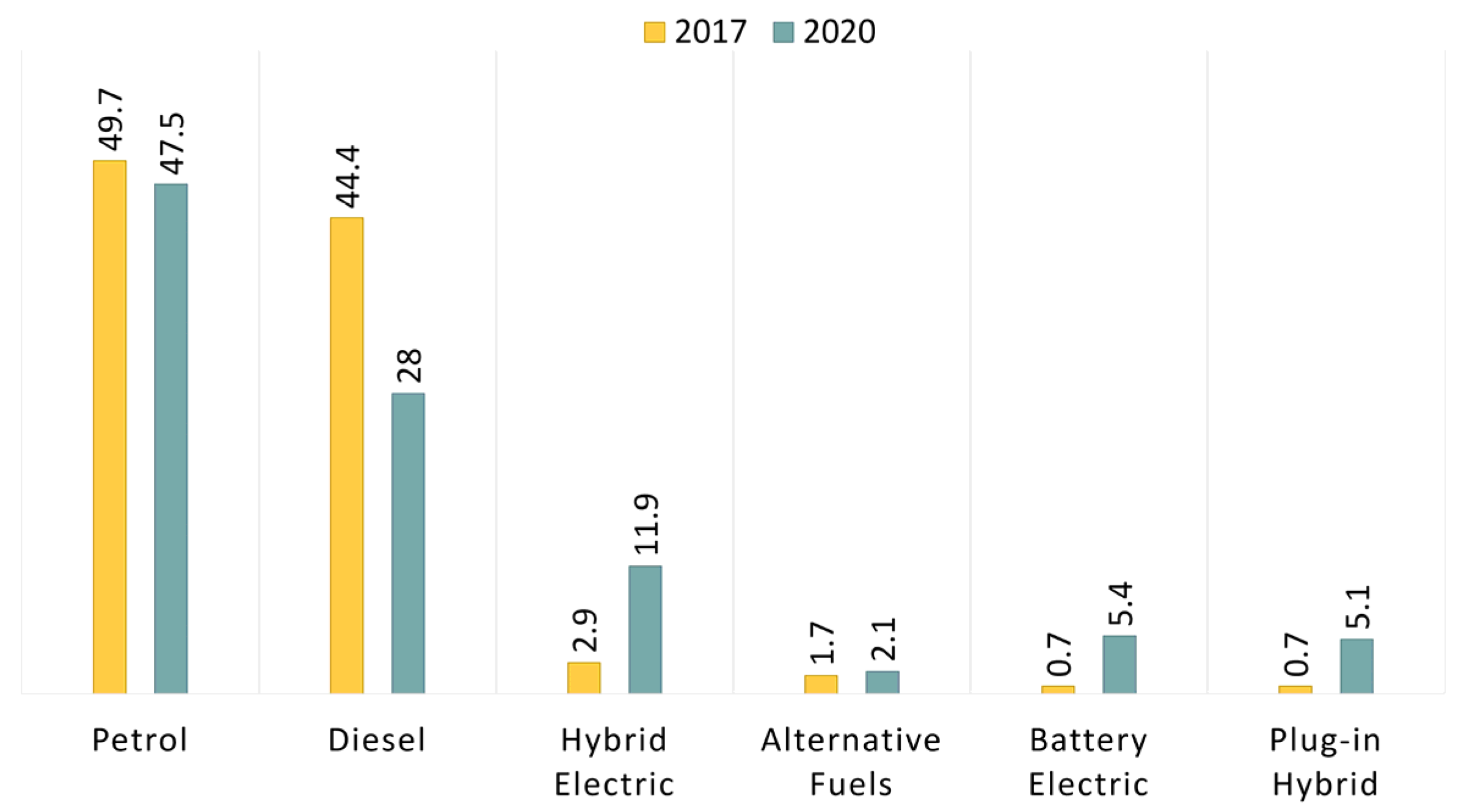

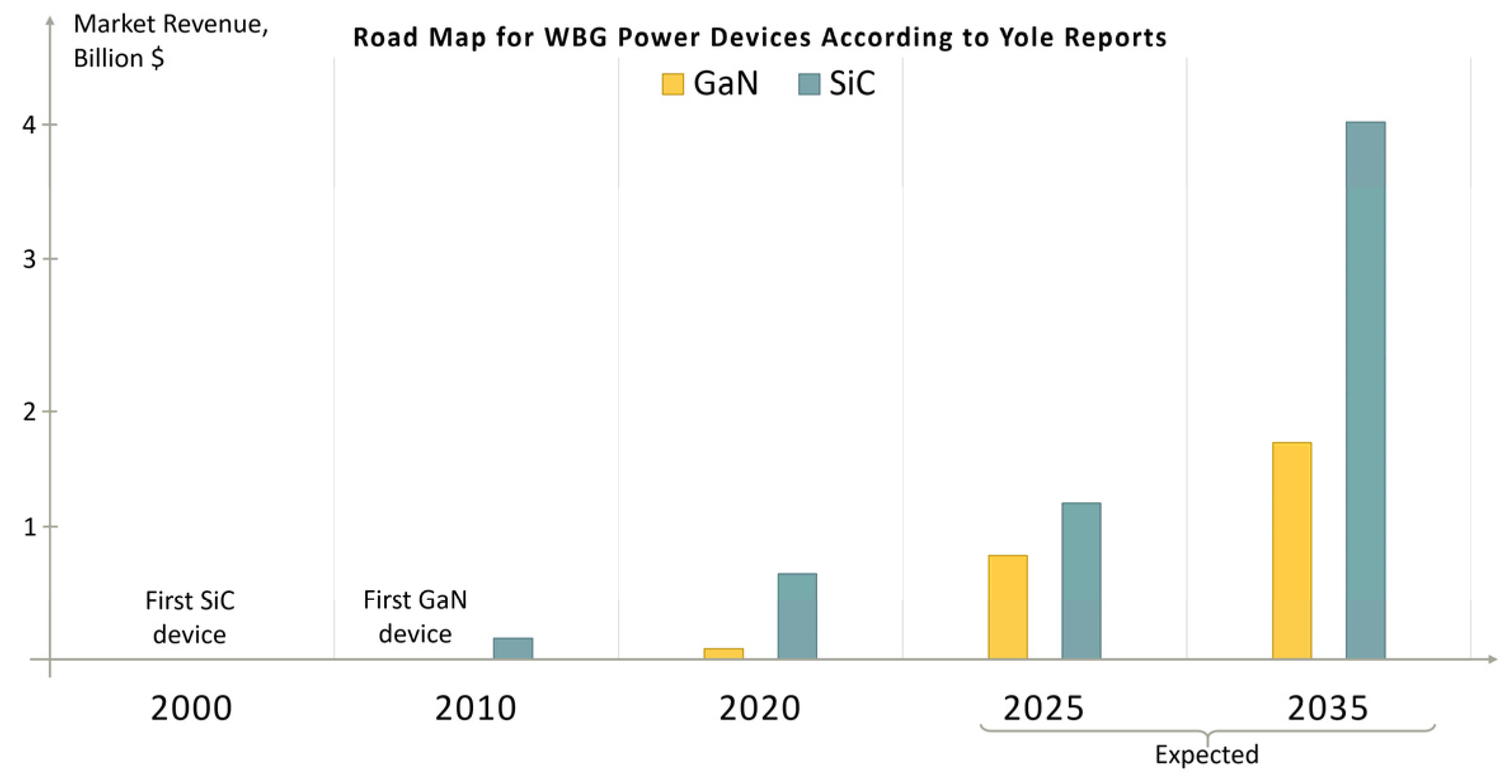



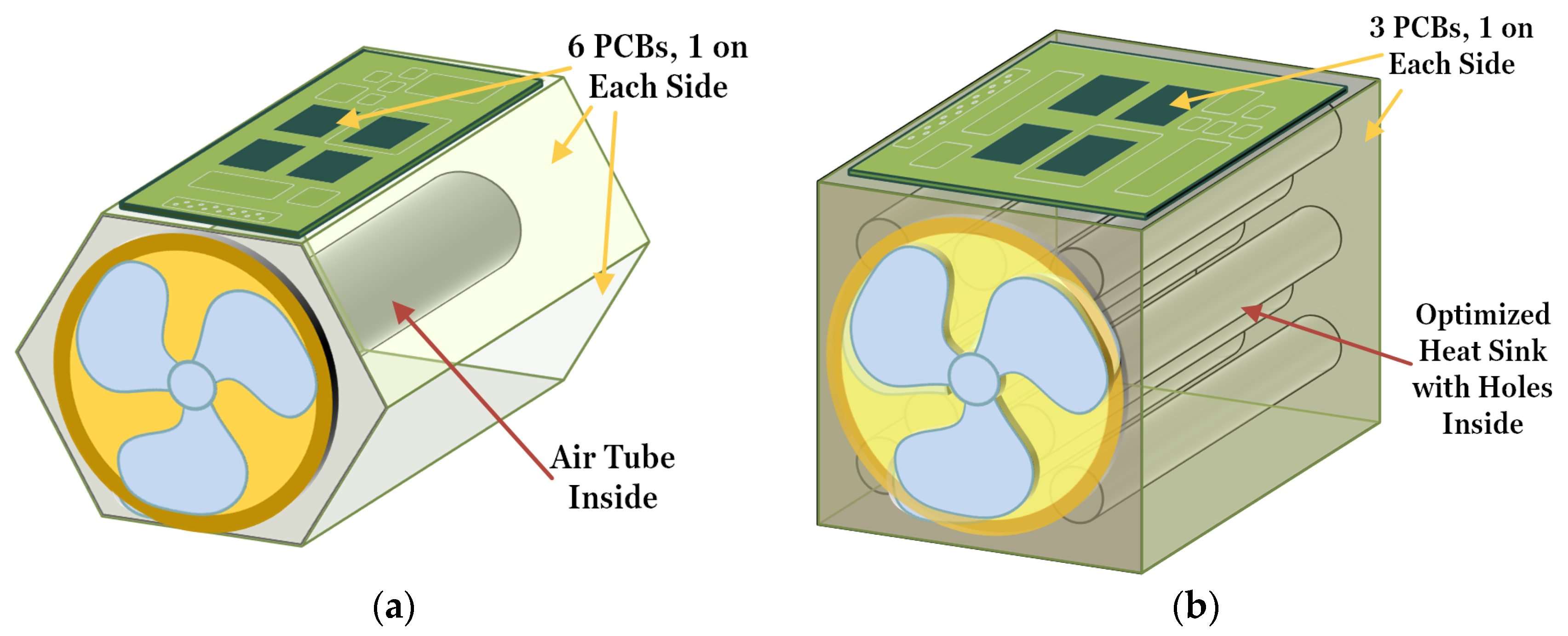
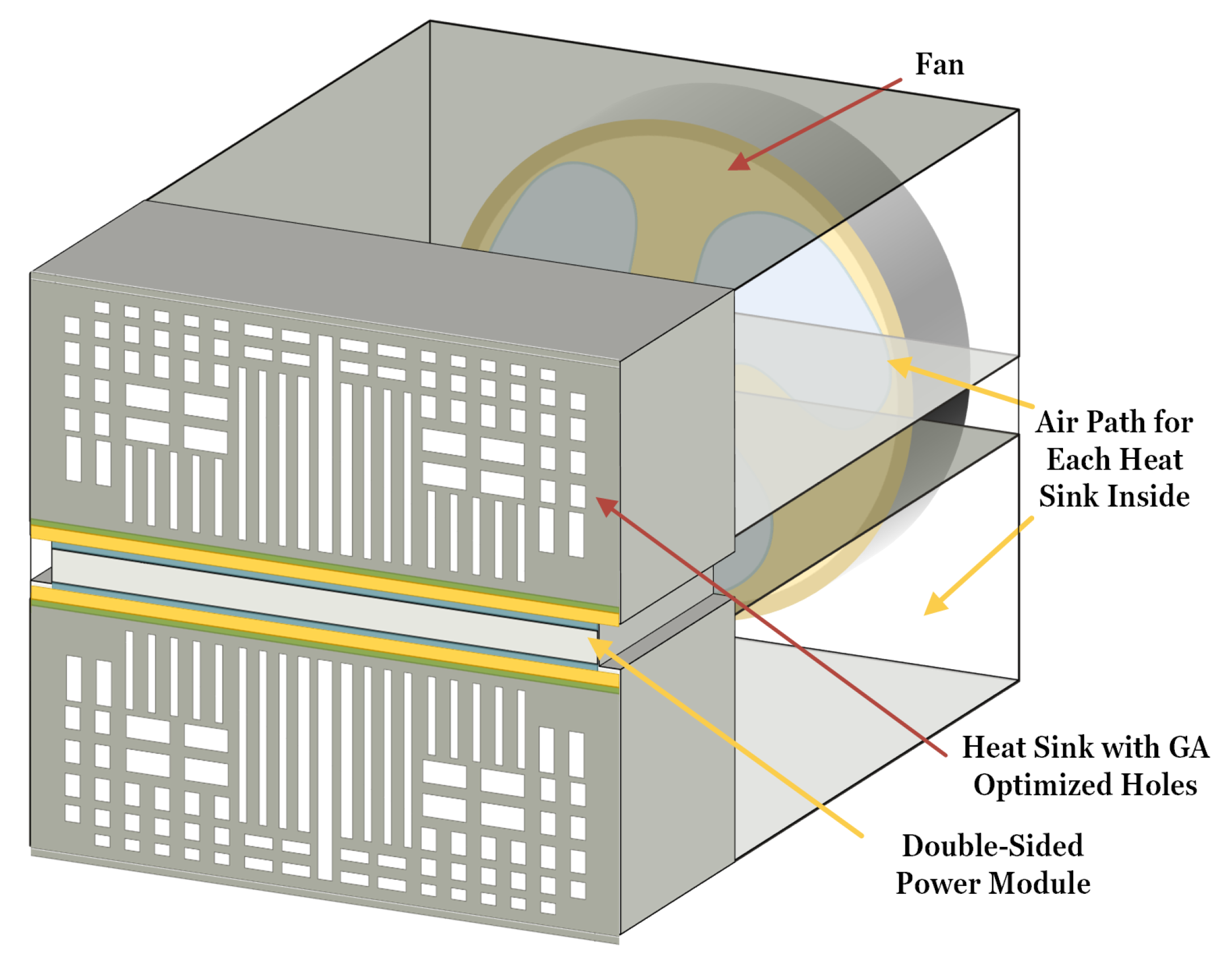
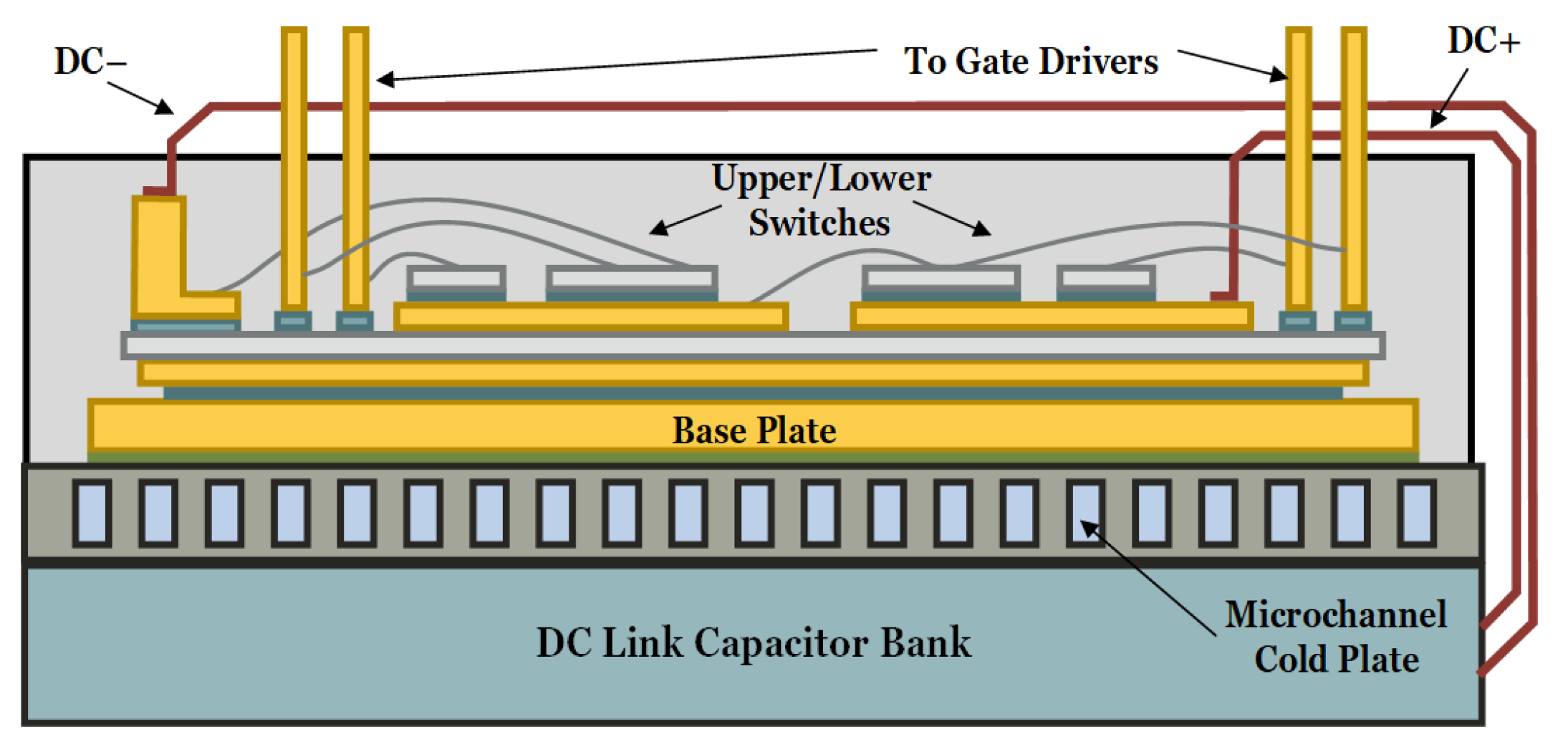
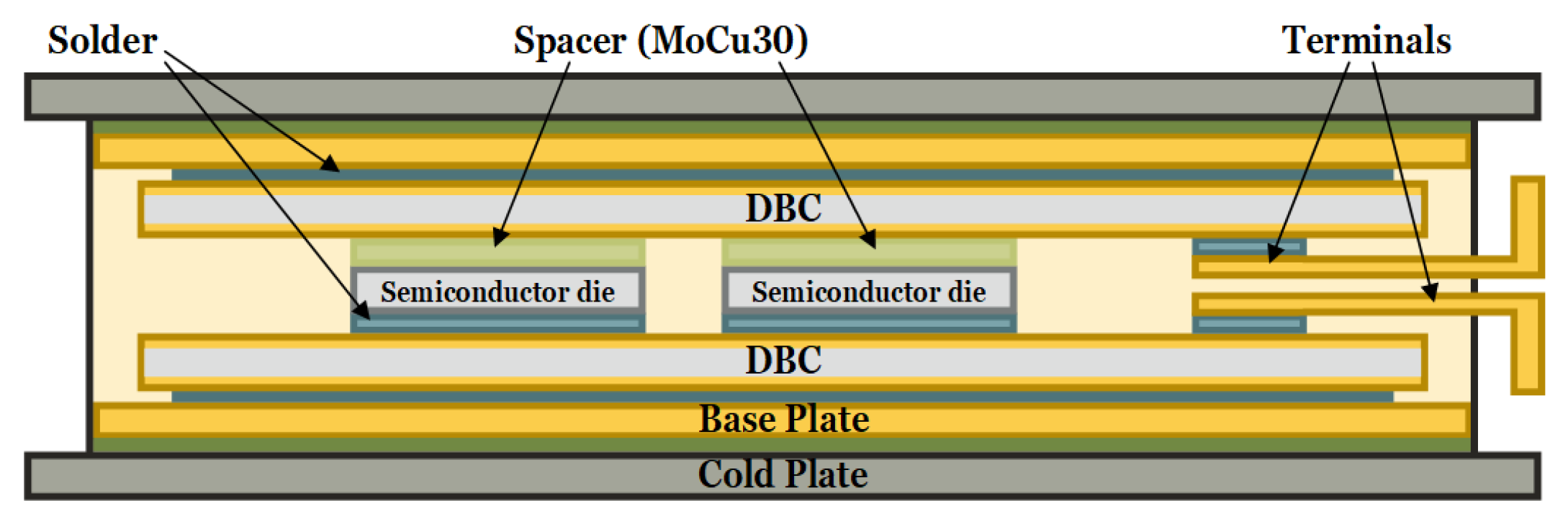




| Ref. No | Cooling | WBG Type | Power, kW /fs, kHz | Heat Sink or Cold Plate | Ambient T, °C /In. Coolant T, °C /In. Speed, l/min | Tjmax, °C | Rth, KW | Power Density, kW/L | Key Conclusions |
|---|---|---|---|---|---|---|---|---|---|
| [18] | Forced-air | 1.2 kV/50 A SiC | 10/50 | Finned heat sink | 25/-/- | 140 | j-amb. 0.35 | 13 | The forced air cooling is feasible for the low power SiC inverter. |
| [86] | Forced-air | 1.2 kV/75 A SiC MOSFET | 2 × 27/100 | Flat hexagonal heat sink | 23/-/- | 105 | j-h.s. 1.0 | 17.2 | The air-cooled hexagonal construction with a fan inside is a low inductivity, compact, and high-power density solution. |
| [87] | Forced-air | 1.2 kV/120 A SiC | 20/20 | 3D, 3-sided heatsink with air path pattern | 25/-/- | 106 | - | 18.6 | The 3D SiC inverter with an integrated heat sink. The heat sink optimized through distribution and diameter of holes in an air path pattern. |
| [88] | Forced-air | 1.2 kV/300 A SiC | 5 × 100/20 | Finned heat sink | 40/-/- | 133 | j-amb. 0.071 | 1.25 | Five 100 kW inverters paralleled to achieve a high efficiency 500 kW inverter. |
| [89] | Forced-air | 1.7 kV SiC MOSFET | 50/20 | Finned heat sink | -/75/- | 103 | - | 1.8 | The GA-optimized heat sink allows an increase in the heat dissipation capability and decrease in the junction temperature. |
| [93] | Liquid | 1.2 kV/450 A SiC | 4/10 | Cold plate, rectangular pins | 105/65/10 water/ethylene | 117 | j-case 0.026 | - | Short time overloading with 55% heat increase allows the heat sink temperature to be maintained beneath the limits. |
| [97] | Liquid | - SiC MOSFET | 125/30 | Micro-channel heat sink | 105/65/10 water/ethylene | 110 | - | - | The manifold microchannel (MMC) heat sink is made of a high thermal conductivity material and exploited in the dual-sided heat sink design. The second side cools the capacitors. |
| [94] | Liquid | 1.2 kV/450 A SiC MOSFET | 30/20 | Pin-fin cold plate | 140/105/10 water/ethylene | - | - | 17 | The inverter is designed for operating at a high ambient temperature. The coolant temperature is considered to be 105 °C to use a single cooling loop for the inverter and motor. |
| [95] | Liquid | 1200 V/300 A SiC MOSFET | 30/10 | Commercial cold plate | 180/50/- water/ethylene | 150 | j-case 0.2 | - | The inverter showed satisfying operating performance at the 180 °C ambient temperature because the high-temperature SiC packaging was used. |
| [96] | Liquid | - SiC MOSFET | 100/40 | 62 mm wide, 007-MXQ-01 cold plate | 105/65/10 | 113 | j-case 0.16 | 34 | A high-power density liquid-cooled inverter is presented. |
| [76] | Liquid | - SiC MOSFET | -/12 | Double-sided cold plate | - | 150 | j-cool. 0.17 | - | The double-sided cold plate with the direct liquid approach allows the thermal resistance from the junction to coolant to be decreased by 35%. |
Publisher’s Note: MDPI stays neutral with regard to jurisdictional claims in published maps and institutional affiliations. |
© 2021 by the authors. Licensee MDPI, Basel, Switzerland. This article is an open access article distributed under the terms and conditions of the Creative Commons Attribution (CC BY) license (https://creativecommons.org/licenses/by/4.0/).
Share and Cite
Abramushkina, E.; Zhaksylyk, A.; Geury, T.; El Baghdadi, M.; Hegazy, O. A Thorough Review of Cooling Concepts and Thermal Management Techniques for Automotive WBG Inverters: Topology, Technology and Integration Level. Energies 2021, 14, 4981. https://doi.org/10.3390/en14164981
Abramushkina E, Zhaksylyk A, Geury T, El Baghdadi M, Hegazy O. A Thorough Review of Cooling Concepts and Thermal Management Techniques for Automotive WBG Inverters: Topology, Technology and Integration Level. Energies. 2021; 14(16):4981. https://doi.org/10.3390/en14164981
Chicago/Turabian StyleAbramushkina, Ekaterina, Assel Zhaksylyk, Thomas Geury, Mohamed El Baghdadi, and Omar Hegazy. 2021. "A Thorough Review of Cooling Concepts and Thermal Management Techniques for Automotive WBG Inverters: Topology, Technology and Integration Level" Energies 14, no. 16: 4981. https://doi.org/10.3390/en14164981
APA StyleAbramushkina, E., Zhaksylyk, A., Geury, T., El Baghdadi, M., & Hegazy, O. (2021). A Thorough Review of Cooling Concepts and Thermal Management Techniques for Automotive WBG Inverters: Topology, Technology and Integration Level. Energies, 14(16), 4981. https://doi.org/10.3390/en14164981









